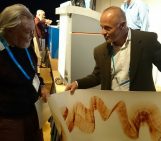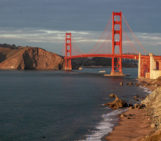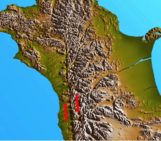
Strike-slip faults by Arthur Sylvester (1988) is a must-read paper for anyone, and more so for those who want to understand the mechanisms of strike-slip faulting. Although it mostly refers to the San Andreas fault, the most studied strike-slip fault at the time (and possibly to date), the contribution is a comprehensive review of the state of the art about strike-slip faults in general. Sylvester presents the concept of strike-slip fault not only from a purely descriptive point of view, but also concerning the mechanics, the different tectonic settings where strike-slip faulting occurs, and the influencing factors such as sedimentation.
The variability in kinematics of a strike-slip fault system is not limited to solely strike-parallel movement, and this created a certain degree of confusion at the beginning of the 20th century, especially concerning nomenclature and definition of different kinds of strike-slip faults, initially called ‘wrench faults’ (Fig. 1). Sylvester explains very clearly the struggle in the recognition of strike-slip features in the field and their consequent attribution to the correct kinematics, which caused many strike-slip faults to ‘disguise’ as dip-slip structures at least until the large 1905 San Francisco earthquake.
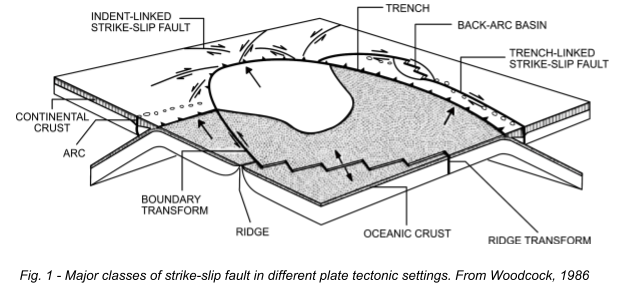
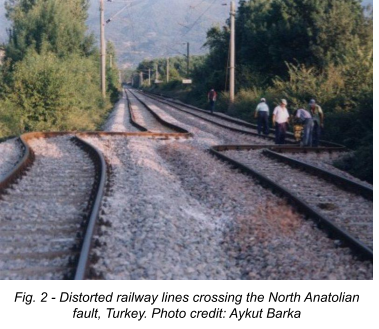
Particular focus is placed on en échelon folds, considered as useful structural indicators to spot the presence of a strike-slip fault at depth, as well as kinematic indicators for fault movement and secondary faults’ distribution.
Overall the author presents strike-slip faults as the structures hosting the largest amount of earthquakes, the greater degree of aftershocks (and afterslip), and the only ones
experiencing fault creep (see also Wesson, 1988). In retrospect, this exclusivity may be explained by the limited resolution and the spatial and temporal distribution of instrumental networks, which restricted the reconnaissance of smaller seismic and geodetic signals on dip-slip structures. In particular, it is obvious how fault creep could be more easily recognised visually on the field along a strike-slip fault than along other faults (Fig. 2).
At depth, on the other hand, the knowledge of strike-slip faults was derived almost exclusively from analogue experiments using clay (e.g. Reches, 1988). The issue associated with this material and model set up is the lack of heterogeneities: in nature the stratigraphy of a sedimentary basin varies in rock composition, and this can influence the dip of a strike-slip fault. In contrast, the faults formed in the experiments remained vertical at great depth, while seismic reflection data show how they could merge to deep detachment faults (Sylvester, 1988).
Sylvester’s paper was published in a time when strike-slip faults were subject to a vibrant research activity, with particular focus on the San Andreas fault (e.g. Sieh et al., 1984; Weldon 1986; Wesnousky, 1988). For instance, the innovative idea of an existing relationship between earthquake size, frequency, and possibly fault-segment length (Sibson, 1987), prelude to the well-known empirical relationship of Wells and Coppersmith (1994), was just making its way into researchers’ minds. Similarly, analogue modelling of strike-slip systems with increasingly accurate model set-ups saw a growing interest during the 1990s (e.g., McClay, 1989; McClay and Dooley, 1994).
Akinbobola Akintomide, Silvia Crosetto, M. Francesca Ferrario (Reddit profile name: GingerFault), and Esophian (Reddit profile name) contributed to the discussion on Reddit. Every contributor expressed their ‘favourite’ part of the paper, which reflects how this reading was a pleasant and relaxing activity. The main point emerging in the discussion is the completeness of the contribution, expressed in the different perspectives the various examples are taken from (regional geodynamics to field geology, analogue modelling, seismic interpretation), as well as in the intriguing and exhaustive explanations of strike-slip dynamics in different settings.
Overall, we can only agree on this publication being a must-read paper for anyone who is approaching the strike-slip world!
Written by Akinbobola Akintomide, Silvia Crosetto, Adriana Guatame-Garcia, and the TS Must Read team
References
McClay K, Dooley T., 1995. Analogue models of pull-apart basins. Geology, 23(8), pp. 711-714.
Sylvester, A. G., 1988, Strike-slip faults: GSA Bulletin, v. 100, no. 11, p. 1666-1703.
Wilson, J. T. 1965, A New Class of Faults and their Bearing on Continental Drift. Nature, 207, pp. 343-347.https://websites.pmc.ucsc.edu/~rcoe/eart206/Wilson_NewClassofFaults_Nature65.pdf

